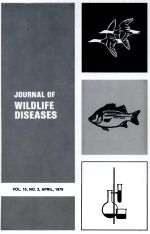Lesions were noted in 7.0 and 4.4% of mandible pairs collected from the Western Arctic caribou herd of northwestern Alaska in 1959-61 and 1975-77, respectively. The prevalence of mandibular lesions in the 1959-61 collection is believed to be the highest reported in wild caribou herds of North America. The frequency of occurrence of mandibular lesions was highest in caribou 7 years of age and older, and there was a higher prevalence in adult males than in adult females.
Trauma, dental abscesses, and periodontal disease were the probable cause of most lesions. Pathogenic bacteria were not isolated from mandibular lesions from an 11 year-old female. Thirty-three of 98 (33.7%) mandibles with lesions were missing one tooth, while ten (10.2%) were missing more than one tooth. The first molar (M1) was the most common tooth lost in association with lesions, although the loss of two or more teeth was more common among premolars than among molars.





